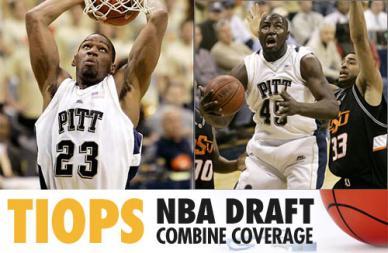
By Paul Ladewski
CHICAGO — In four years at Pitt, Sam Young was almost anything that we wanted to be. There was Sam Young the poet. Sam Young the pianist. Sam Young the bowler. Sam Young the power forward. Sam Young the small forward. And don’t forget Sam Young, UConn-killer.
But there’s at least one Sam Young that has rarely been seen before. He’s the version that Young plans to unveil at private workouts in advance of the NBA draft next month, one that he believes will raise some eyebrows along the way.
Meet Sam Young, slam-dunkin’ three-point-drainin’, lockdown defendin’ off guard.
The majority of NBA draftniks consider Young to be a 6-foot-6 small forward at the next level, but he is fully intent to change some minds in the days and months ahead.
“For sure,” Young told Inside Pittsburgh Sports at the NBA Combine. “A lot of people don’t think that I can play the two guard, but my ball-handling has gotten to a point that I will play a lot there. I can even bring the ball up the floor. When all is said and done, I’ll definitely be a two.”
In the last two months, Young spent long hours to acclimate himself to the three-point shot, NBA style. In the pros, the arc is located 23 feet, nine inches from the basket, three feet further than in the college game.
“At the beginning, I thought it would affect me a little bit,” Young said of the added distance. “But now, I’m shooting it pretty consistently, especially at the private workouts and (the NBA Combine).
At Pitt, Young made strides as a three-point threat each year. His attempts increased from 21 to 42 to 115 to 145 last season, while his success rate went from 19 to 36 to 38 to 37 percent.
Said Young, “That’s not all I want to do at the offensive end. I can score the ball for myself, but I want to make plays for other guys, too. That’s another part of my game that I’ve worked on lately.”
In a league that places a premium on versatility, the ability to play multiple positions is no small consideration.
As someone who could outquick bigger guards and shoot over smaller ones, Young would represent a matchup nightmare. Plus, Young would become a valuable moveable piece that could defend at any one of three spots on the court.
If Young makes a good first impression in the backcourt, it could assure him of a spot in the mid-to-late first round next month. He worked out for the Indiana Pacers (13th pick) and Chicago Bulls (16th , 26th) recently.
“Right now, I believe that I can guard the two, the three and the four (positions),” he said. “My strength and athletic ability will take me a long way.”
At Pitt, Young was stifled by highly-structured rules and systems at times. Sort of like a thoroughbred with Charles Barkley on its back. He never averaged as many as 15 field-goal attempts or 20 points per game in any season.
More than one talent evaluator believes that Young is much better suited for the wide-open spaces that the NBA game will offer him.
“I think so,” Young said. “I’m more of a one-against-one player. I love to be in those situations, and in the NBA, the floor is spaced out more. In college, there’s a lot of help defense that you don’t see as much of there. Those things will complement my game, and I can’t wait to showcase it.”
Young may have offered a glimpse of the future in the NCAA Tournament earlier this spring. Finally cast in the role of go-to guy, he took poetry in motion to another level.
In four games, he averaged 23.3 points and 7.8 rebounds per game, shot 52 percent in the field and converted 48 percent of his three-point tries.
Detractors point out that Young was a 23-year-old senior at the time – he will turn 24 next week – but he considers his age to be an asset, not a negative.
“That always will be an issue,” Young said. “In this business, you always look for youth. But I want teams to know that they won’t get a kid who will go crazy off the court but a guy who will be a team leader as a rookie. I feel like I get better every day. I won’ be drafted on potential.”

